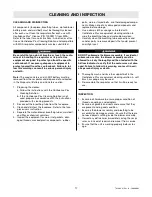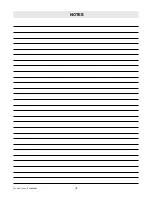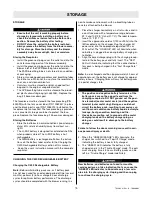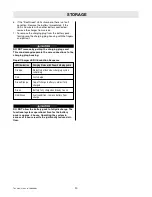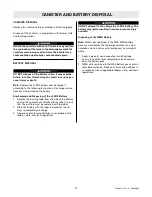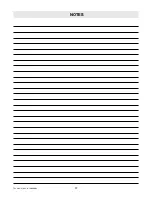
GENERAL DESCRIPTION
DESCRIPTION
The FireHawk M7 Responder PAPR Respirator is a blow-
er-assisted, air-purifying respirator referred to as a
Powered Air-Purifying Respirator or a PAPR.
The filtering system consists of the C420 waist-mounted
battery driven motor-blower assembly device and two (2)
canister-type filter media. The blower assembly contains
an electric motor driving an air blower. A compartment for
a non-rechargeable 6 volt (nominal) lithium-sulfur dioxide
(LiSO2) battery pack or a rechargeable 4.8 volt (nominal)
nickel-metal hydride (NiMH) battery pack is located on the
bottom of the blower assembly. There are two (2) thread-
ed inlets on the front of the blower assembly for the
attachment of the canisters (sold separately). The user of
the respirator breathes ambient air after the air has
passed through the canisters. The canisters include a
mechanical filter to trap airborne particles and may also
include a sorbent bed of impregnated activated carbon to
trap and/or neutralize various gases/vapors.
The blower assembly assists breathing by drawing air
through the canisters and delivering the purified air
through a breathing tube to the facepiece. An airflow indi-
cator used to check for minimum airflow is provided with
the C420 PAPR filtering system. To maintain respiratory
protection:
•
The user must be properly fit tested to the respirator
facepiece before use (refer to the appropriate
Facepiece User Instructions Manual)
•
The blower, with canisters installed, must be tested
with the airflow indicator both prior to use and at pre-
scribed intervals during use to monitor battery life and
canister efficiency.
The FireHawk M7 Responder PAPR can be used with the
FireHawk M7 Responder APR. Refer to the separate
NIOSH Approval Label (P/N 10086005) for a complete list
of approved part numbers and limitations.
RESPIRATOR USE LIMITATIONS
The respirator must not be worn in atmospheres which
exceed any of the following limitations:
1. Maximum use concentrations
a. Full facepiece: 1000 times the exposure limit for the
contaminants present.
b. 1000 parts per million organic vapors (for organic
vapor respirators).
2. The limitations outlined in the applicable NIOSH
approval.
3. Any applicable limitation contained in a standard
established by a regulatory agency (such as OSHA)
with jurisdiction over the wearer.
4. This respirator can be used for protection against a
mixture of contaminants that are present simultane-
ously or alternately against one contaminant then
another (using the same canisters or filters) if the mix-
ture meets the following conditions:
a. The canister/filter must be approved for all contami-
nants present.
b. Particulates (dusts, mists, fumes, asbestos,
radionuclides) can be mixed with any other particu-
late or any gas or vapor for which the canister is
approved.
c. Contaminants present simultaneously must be
below IDLH levels for the specific contaminants. If
any one contaminant in the mixture exceeds the
IDLH concentration then the entire mixture must be
treated as IDLH and the respirator cannot be used
(except for escape from particulates with appropri-
ate filter).”
EXPOSURE LIMITS
A listing of acceptable exposure limits from the following
sources is provided in MSA’s Response® Respirator
Selector:
-
American Conference of Governmental Industrial
Hygienists (ACGIH)
-
Occupational Safety and Health Administration
(OSHA)
-
National Institute for Occupational Safety and Health
(NIOSH)
-
American Industrial Hygiene Association (AIHA)
Contact MSA at 1-800-MSA-2222 for information.
Exposure Limits for Mixtures
The American Conference of Governmental Industrial
Hygienists (ACGIH) publishes the following information to
determine the Threshold Limit Value (TLV) of a mixture.
First determine the total concentration of the chemical
mixture (CMixture) from the individual contaminant con-
centrations (C1, C2, C3, . . . ) using the following formula:
CMixture=C1+C2+ C3+ . . .
The TLV of the mixture is found by using the following for-
mula where T1, T2, T3, . . . are the individual contaminant
TLVs and C1, C2, C3, . . . are the individual contaminant
concentrations:
Only use these equations if the contaminants present are
actually mixed. Some substances do not mix and may be
present separately, for example, in pockets or at different
levels. In that case, the lowest TLV of the substances pre-
sent must be used to determine the appropriate respirator
category for protection against all contaminants present.
7
TAL 804 (L) Rev. 0 - 10086003
C
mixture
T
mixture
C
1
T
1
+
C
2
T
2
+
C
3
T
3
Summary of Contents for FireHawk M7 Responder PAPR
Page 4: ...NOTES 4 TAL 804 L Rev 0 10086003 ...
Page 16: ...NOTES 16 TAL 804 L Rev 0 10086003 ...
Page 18: ...NOTES 18 TAL 804 L Rev 0 10086003 ...
Page 22: ...NOTES 22 TAL 804 L Rev 0 10086003 ...
Page 24: ......

















